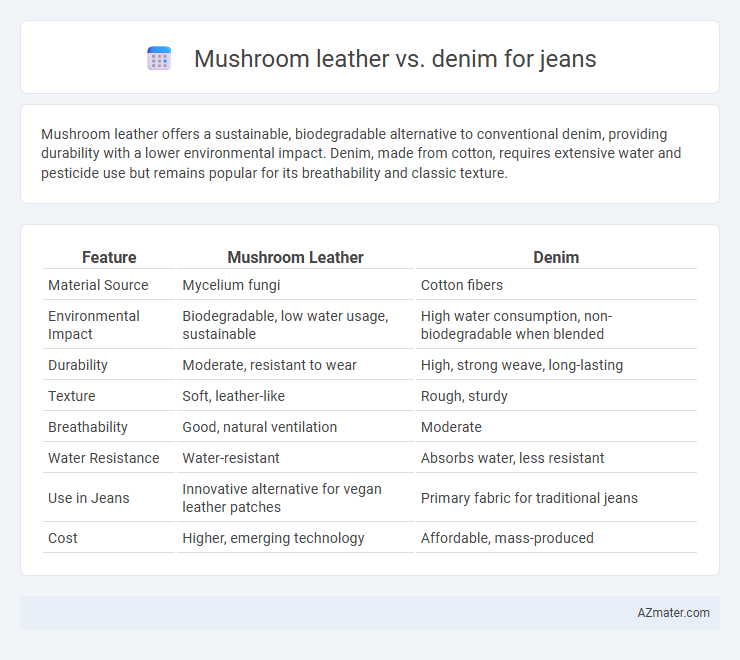Mushroom leather offers a sustainable, biodegradable alternative to conventional denim, providing durability with a lower environmental impact. Denim, made from cotton, requires extensive water and pesticide use but remains popular for its breathability and classic texture.
Table of Comparison
| Feature | Mushroom Leather | Denim |
|---|---|---|
| Material Source | Mycelium fungi | Cotton fibers |
| Environmental Impact | Biodegradable, low water usage, sustainable | High water consumption, non-biodegradable when blended |
| Durability | Moderate, resistant to wear | High, strong weave, long-lasting |
| Texture | Soft, leather-like | Rough, sturdy |
| Breathability | Good, natural ventilation | Moderate |
| Water Resistance | Water-resistant | Absorbs water, less resistant |
| Use in Jeans | Innovative alternative for vegan leather patches | Primary fabric for traditional jeans |
| Cost | Higher, emerging technology | Affordable, mass-produced |
Introduction to Mushroom Leather and Denim
Mushroom leather, derived from mycelium, offers a sustainable and biodegradable alternative to traditional textiles, showcasing durability and a unique texture that appeals to eco-conscious consumers. Denim, a cotton twill fabric, remains a classic choice for jeans due to its robustness, comfort, and timeless style, though it typically involves higher water and chemical usage in production. Comparing mushroom leather versus denim highlights the growing demand for environmentally friendly materials in fashion without compromising functionality and aesthetics.
Origins and Production Processes
Mushroom leather is crafted from mycelium, the root structure of fungi, grown in controlled environments, enabling rapid and sustainable production with minimal water and chemical use. Denim, traditionally made from cotton fibers, requires extensive water, pesticides, and energy-intensive processing, including dyeing and weaving, contributing to environmental concerns. The origins of mushroom leather as a fungal biomaterial offer an innovative, eco-friendly alternative to the conventional agricultural dependence seen in denim manufacturing.
Environmental Impact Comparison
Mushroom leather, derived from mycelium, offers a sustainable alternative to denim with a significantly lower environmental footprint due to its rapid growth, minimal water usage, and biodegradability. Denim production involves intensive water consumption, pesticide use, and carbon emissions from cotton farming and dyeing processes. Choosing mushroom leather for jeans reduces pollution and resource depletion, aligning with eco-friendly fashion initiatives aimed at minimizing textile industry waste.
Durability and Longevity
Mushroom leather offers impressive durability with natural resistance to wear and tear, making it an eco-friendly alternative to traditional materials. Denim, known for its strong cotton fibers, provides excellent longevity through repeated washings and heavy use, often improving in texture over time. Both materials excel in durability, but mushroom leather's innovative composition resists cracking and fading, while denim remains favored for its classic resilience and long-term comfort.
Comfort and Wearability
Mushroom leather offers superior breathability and flexibility compared to denim, enhancing comfort during prolonged wear. Its natural moisture-wicking properties prevent overheating and reduce skin irritation, making it ideal for varied climates. Denim, while durable and sturdy, tends to be less forgiving in mobility and can cause discomfort due to its heavier fabric and slower moisture evaporation.
Aesthetic Differences
Mushroom leather offers a smooth, matte finish with organic textures that create a sleek, modern aesthetic contrasting with denim's classic ruggedness and distinctive weave patterns. The natural variations in mushroom leather provide a unique, eco-friendly appeal ideal for luxury and avant-garde jeans, while denim maintains a timeless, casual look characterized by its visible stitching and fading potential. These material choices significantly influence the visual identity of jeans, with mushroom leather delivering sophistication and denim emphasizing durability and heritage.
Cost and Market Availability
Mushroom leather, derived from sustainable mycelium, typically carries a higher production cost compared to conventional denim, making it less accessible in the mass market. Denim, produced from cotton, benefits from well-established manufacturing processes and widespread availability, resulting in lower prices and extensive market presence. The niche status of mushroom leather in fashion limits its market penetration, while denim remains the dominant material choice for jeans worldwide.
Sustainability and Eco-Friendliness
Mushroom leather offers a highly sustainable alternative to traditional denim by using mycelium, a renewable natural material that requires less water and no pesticides, significantly reducing environmental impact. Denim production involves intensive water usage and chemical treatments that contribute to pollution and resource depletion. Choosing mushroom leather for jeans supports eco-friendly fashion through biodegradable materials and a lower carbon footprint compared to conventional cotton denim.
Consumer Perception and Trends
Mushroom leather is gaining traction in the fashion industry due to its sustainability and eco-friendly production, appealing to environmentally conscious consumers seeking alternatives to conventional denim. Denim remains a staple in jeans manufacturing, valued for its durability and classic aesthetic, but faces criticism for high water usage and environmental impact. Consumer trends increasingly favor mushroom leather for its innovation and lower carbon footprint, signaling a shift toward plant-based materials in casual wear.
Future of Sustainable Jeans
Mushroom leather offers a biodegradable and renewable alternative to traditional denim, significantly reducing water usage and carbon emissions in jean production. Innovations in mycelium-based materials enhance durability and flexibility, positioning mushroom leather as a viable option for long-lasting sustainable jeans. As consumer demand shifts towards eco-friendly apparel, integrating mushroom leather with recycled denim fibers could reshape the future of sustainable jeans in the fashion industry.

Infographic: Mushroom leather vs Denim for Jean
 azmater.com
azmater.com